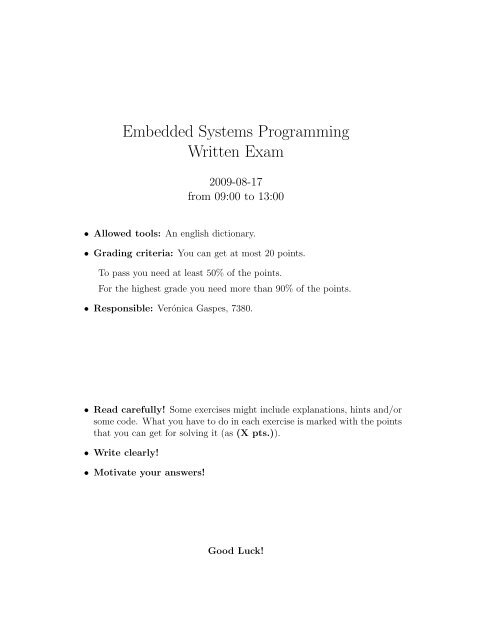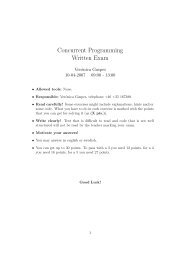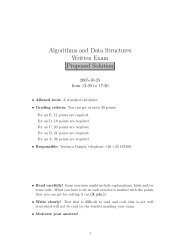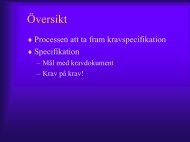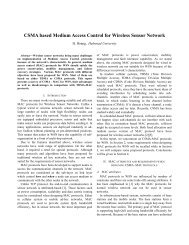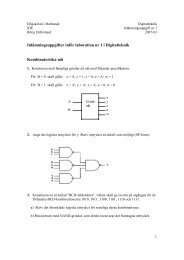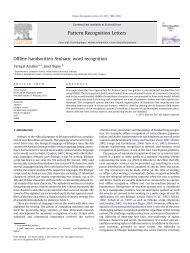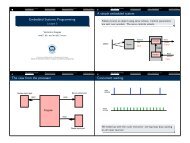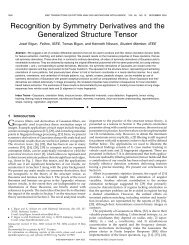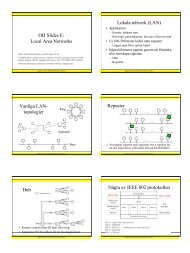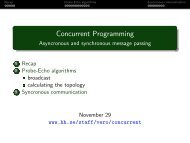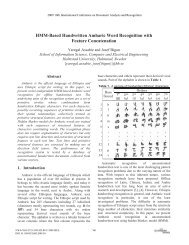Embedded Systems Programming Written Exam
Embedded Systems Programming Written Exam
Embedded Systems Programming Written Exam
Create successful ePaper yourself
Turn your PDF publications into a flip-book with our unique Google optimized e-Paper software.
<strong>Embedded</strong> <strong>Systems</strong> <strong>Programming</strong><br />
<strong>Written</strong> <strong>Exam</strong><br />
2009-08-17<br />
from 09:00 to 13:00<br />
• Allowed tools: An english dictionary.<br />
• Grading criteria: You can get at most 20 points.<br />
To pass you need at least 50% of the points.<br />
For the highest grade you need more than 90% of the points.<br />
• Responsible: Verónica Gaspes, 7380.<br />
• Read carefully! Some exercises might include explanations, hints and/or<br />
some code. What you have to do in each exercise is marked with the points<br />
that you can get for solving it (as (X pts.)).<br />
• Write clearly!<br />
• Motivate your answers!<br />
Good Luck!
1. (3 pts.) Write functions<br />
void setBit(unsigned int *port, int bitNr)<br />
void clearBit(unsigned int *port, int bitNr)<br />
to set resp. clear a given bit in a port. The bit that has to be set or made<br />
clear in the port is given by the second argument (bitNr) to the functions.<br />
Bit number 0 is the least significant bit.<br />
2. (3 pts.) Consider the following fragments we discussed in one of the lectures.<br />
The first two functions use busy waiting to detect and read input<br />
values from a sonar and a radio device. We do not show the code for the<br />
functions that implement ordinary algorithms (control and decode) and<br />
for generating output to the servo device.<br />
int sonar_read(){<br />
while(SONAR_STATUS & READY == 0);<br />
return SONAR_DATA;<br />
}<br />
void radio_read(struct Packet *pkt){<br />
while(RADIO_STATUS & READY == 0);<br />
pkt->v1 = RADIO_DATA1;<br />
...<br />
pkt->vn = RADIO_DATAn;<br />
}<br />
main(){<br />
struct Params params;<br />
struct Packet packet;<br />
int dist, signal;<br />
while(1){<br />
dist = sonar_read();<br />
control(dist, &signal, ¶ms);<br />
servo_write(signal);<br />
}<br />
}<br />
radio_read(&packet);<br />
decode(&packet,¶ms);<br />
Discuss some of the problems with this style of programming. Show some<br />
way of modifying the program so that one of the input sources does not<br />
shadow the other one. Are there some remaining problems?<br />
2
3. (3 pts.) In the following fragment from laboration 2 there is a critical<br />
section. Identify it, explain what may happen, give an example of incorrect<br />
behaviour and solve the problem using a mutex.<br />
#include "tinythreads.h"<br />
int pp;<br />
void writeChar(char ch, int pos); // defined elsewhere<br />
int is_prime(long i);<br />
// defined elsewhere<br />
void printAt(long num, int pos) {<br />
pp = pos;<br />
writeChar( (num % 100) / 10 + ’0’, pp);<br />
pp++;<br />
writeChar( num % 10 + ’0’, pp);<br />
}<br />
void computePrimes(int pos) {<br />
long n;<br />
for(n = 1; ; n++) {<br />
if (is_prime(n)) printAt(n, pos);<br />
}<br />
}<br />
int main() {<br />
spawn(computePrimes, 0);<br />
computePrimes(3);<br />
}<br />
4. Using Tinytimber you can organize programs with reactive objects while<br />
programming in C. As a programmer you have to follow some conventions<br />
and Tinytimber guarantees that the methods of a reactive object are executed<br />
strictly sequentialy, thus protecting the local state of the object from<br />
critical section problems.<br />
(4 pts.) Program a class for reactive objects that can be used to protect<br />
(or encapsulate) an array of integers. The array to be encapsulated can be<br />
provided on object initialization. Let the type introduced for the class be<br />
Array. Then, the methods that have to be provided are<br />
3
ecord a position<br />
int setPosition(Array *self, int x)<br />
// set the value at the recorded position to x<br />
int setElement(Array *self, int x)<br />
// return the value at the recorded position<br />
int getElement(Array *self, int x)<br />
5. (3 pts.) In laboration 4 you used a reactive object to implement a blinker<br />
that turns on and off a LED. The blinker can be started, stopped and<br />
the period can be set. Assuming that you have a class for reactive LEDs,<br />
implement a blinker. The blinker should not be hard-coupled to a LED,<br />
instead, it should be possible to instantiate blinkers for different LEDs.<br />
6. Say that three periodic tasks A, B and C have periods 20, 30, 40 (and<br />
deadline equal to the period).<br />
(a) (1 pts.) What does it mean that A has utilization 50%, B has utilization<br />
25% and C 10%?<br />
(b) (1 pts.) Given these utilizations, what is the total utilization?<br />
(c) (2 pts.) Provide the timelines that result from scheduling according<br />
to rate monotonic (RM) and according to earliest deadline first (EDF).<br />
4


